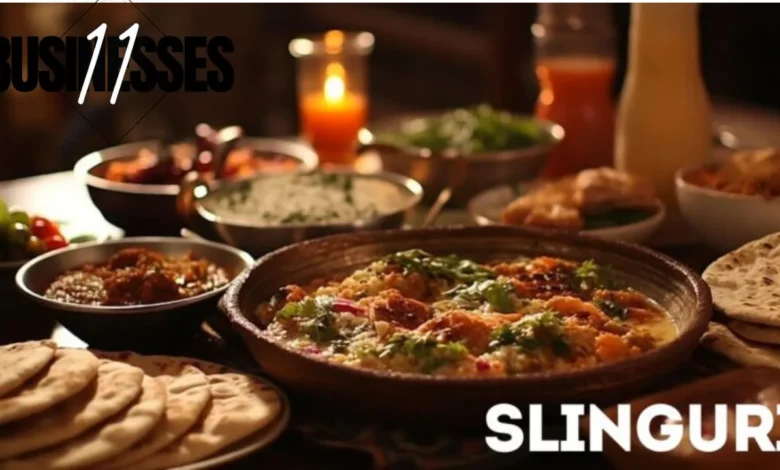Slinguri: A Comprehensive Guide

Slinguri is a traditional dish that originates from the heart of South Asian cuisine. It is primarily made with rice flour and a variety of fillings, which can range from spicy to sweet.
The dish is often associated with festivals and family gatherings, making it a beloved food among many communities. As someone who enjoys exploring different cuisines, I find Slinguri to be a fascinating dish with a rich cultural significance.
It represents not just a meal, but also the traditions and stories passed down through generations.
Slinguri is made by mixing rice flour with water to create a dough-like consistency. This dough is then filled with a mixture of ingredients, which can include vegetables, meat, or sweets.
The filled dough is often shaped into small rounds and either steamed or fried, creating a delightful texture that is both chewy and flavorful.
This dish is not just popular for its taste, but also for its versatility, as it can be enjoyed as a snack, main course, or even dessert.
What Ingredients Are Used in Slinguri?
The ingredients used in Slinguri can vary widely depending on regional preferences and personal tastes. The base ingredient, rice flour, is essential, as it provides the structure of the dish. Water is added to make the dough pliable and easy to work with.
Beyond that, the fillings are what truly define Slinguri. Common fillings include:
Vegetables: Grated carrots, peas, and potatoes are often used to create a savory version. Spices like cumin and coriander add flavor to these fillings.
Meats: For those who enjoy a heartier meal, minced meat, such as chicken or lamb, is a popular choice.
These meats are usually seasoned and cooked before being wrapped in the rice dough.
Sweets: For a dessert version, fillings may include jaggery (a type of unrefined sugar), coconut, and nuts.
This sweet variant of It is often enjoyed during festivals and celebrations.
The combination of these ingredients not only adds flavor but also provides various nutrients, making It a wholesome meal option.
How is It Prepared?
Preparing It involves a few steps, each requiring attention to detail to ensure the best results. Here’s a simple breakdown of the preparation process:
Making the Dough: Start by mixing rice flour with water until it forms a smooth and pliable dough. It’s important to knead it well to achieve the right texture.
Preparing the Filling: While the dough rests, prepare your filling of choice. This may involve cooking vegetables or meat with spices and allowing it to cool.
Assembling It: Take a small portion of the dough and flatten it in your palm. Add a spoonful of filling in the center and carefully fold the edges over to seal the filling inside. It’s essential to ensure there are no openings.
Cooking It: Depending on your preference, you can either steam or fry the assembled It. Steaming gives it a soft, chewy texture, while frying adds a crispy outer layer.
Serving: It can be served with various dipping sauces or chutneys, enhancing its flavor and making it even more enjoyable.
This straightforward process makes it accessible for anyone to try making It at home.
Where Did It Come From?
The Historical Roots of It
It has a rich history that reflects the cultural tapestry of South Asia. While the exact origins of It are difficult to pinpoint, it is believed that the dish emerged centuries ago as communities sought ways to make the most of local ingredients.
The use of rice flour in many South Asian dishes dates back to ancient times, and It is one of the many creative adaptations of this staple.
Throughout history, rice has been a fundamental food source in regions such as India and Pakistan. It likely evolved from the need to utilize leftover ingredients and minimize food waste. It became a practical way to combine different flavors and textures, resulting in the delicious dish we enjoy today. This historical significance adds depth to It, showcasing the ingenuity of those who created it.
Regional Variations of It
One of the fascinating aspects of It is how it varies from region to region. Different cultures have added their unique twists to the dish, resulting in a diverse array of flavors and preparations. Here are some notable regional variations:
Northern India: In the northern regions, It often features a spicy filling made with potatoes and peas. The use of spices such as garam masala and coriander gives the dish a distinctive flavor. It is usually enjoyed as a savory snack during tea time or as part of a larger meal.
Southern India: In Southern India, It may include coconut and jaggery as filling ingredients, resulting in a sweet version. This variant is often served during festivals and is loved for its rich flavors. The addition of fresh coconut gives it a unique texture and aroma.
Pakistani It: In Pakistan, It might be made with minced meat, such as chicken or beef, seasoned with spices. This hearty version is often served at celebrations and gatherings, showcasing the communal aspect of the dish. It highlights the cultural blending of different culinary traditions.
What Are the Health Benefits of It?
It offers several health benefits, making it a great addition to a balanced diet. Here are a few reasons why you might consider adding It to your meals:
Rich in Nutrients: Depending on the fillings, It can be packed with essential vitamins and minerals. Vegetables contribute fiber and nutrients, while meats add protein.
Gluten-Free: Made primarily from rice flour, It is naturally gluten-free. This makes it suitable for individuals with gluten sensitivities or celiac disease.
Low in Calories: When steamed, It is a low-calorie option compared to many fried snacks. This makes it a healthier choice for those watching their weight.
Customizable: You can control the ingredients and portions, allowing you to create a dish that fits your dietary needs or preferences.
Including It in your diet can provide both taste and nutrition, making it a worthwhile choice for many people.
How to Serve It?
Serving It is an essential part of enjoying this dish. Here are some ideas for serving It that can elevate the experience:
With Dipping Sauces: Common accompaniments include spicy chutneys or yogurt-based sauces. These add flavor and a refreshing contrast to the savory or sweet fillings.
As Part of a Platter: It can be part of a larger meal, served alongside other dishes like curries or salads. This makes for a diverse dining experience.
Garnished with Herbs: Fresh cilantro or mint leaves can be used to garnish It, adding a burst of color and flavor.
As an Appetizer or Snack: It is perfect for parties or gatherings. You can serve them in bite-sized pieces, making them easy for guests to enjoy.
By thinking creatively about how to serve It, you can enhance the dining experience for yourself and others.
What Are the Pros and Cons of It?
When considering any dish, it’s essential to weigh the pros and cons. Here’s a quick table outlining the benefits and potential drawbacks of It.
| Pros | Cons |
| Nutrient-rich, depending on fillings | Preparation can be time-consuming |
| Gluten-free option for many diets | Requires specific ingredients like rice flour |
| Customizable to suit personal tastes | Some versions can be high in calories if fried |
| Versatile dish suitable for various meals | May not be well-known in all regions |
| Great for gatherings and celebrations | Needs skill to shape and seal properly |
This table gives a quick overview of what to expect when trying or making It.
How to Store It?
Storing It properly is essential to maintain its freshness and flavor. Here are some tips for effective storage:
Refrigeration: If you have leftovers, allow them to cool completely before placing them in an airtight container. They can be stored in the refrigerator for up to three days.
Freezing: For longer storage, you can freeze It. Arrange them in a single layer on a baking sheet to prevent sticking, then transfer them to a freezer bag once frozen. They can last for up to three months in the freezer.
Reheating: When you’re ready to enjoy stored It, reheat them in a steamer or microwave. If they were fried, a quick fry can restore their crispiness.
By following these storage tips, you can enjoy It even after it’s been prepared.
FAQ About It
What is It made of?
It is primarily made from rice flour, which forms the base of the dish. It can be filled with a variety of ingredients, including vegetables, meats, or sweets, depending on personal preferences and regional variations.
Is It gluten-free?
Yes, It is naturally gluten-free since it is made from rice flour. This makes it suitable for individuals with gluten sensitivities or celiac disease.
How is It prepared?
To prepare It, you make a dough from rice flour and water, fill it with your choice of ingredients, shape it, and then either steam or fry it. Each method gives a different texture and flavor to the dish.
Can Slinguri be made vegetarian?
Absolutely! Slinguri can easily be made vegetarian by using a filling of vegetables, lentils, or paneer. This makes it a versatile dish for people with different dietary preferences.
How should Slinguri be served?
Slinguri can be served as a snack, appetizer, or main dish. It is often accompanied by dipping sauces like spicy chutneys or yogurt sauces to enhance its flavor.
How do you store leftover Slinguri?
Leftover Slinguri can be stored in the refrigerator for up to three days in an airtight container. For longer storage, they can be frozen for up to three months. Just make sure to reheat them properly before serving.
What are the health benefits of Slinguri?
Slinguri is nutrient-rich, especially when filled with vegetables or lean meats. It is low in calories when steamed, and its gluten-free nature makes it suitable for many diets.
Where did Slinguri originate?
Slinguri has its roots in South Asian cuisine, particularly in countries like India and Pakistan. Each region has its unique take on the dish, influenced by local ingredients and culinary traditions.
Can Slinguri be made ahead of time?
Yes, you can prepare Slinguri in advance. You can assemble them and refrigerate or freeze them, then cook them when you’re ready to serve.
Is Slinguri popular at events?
Yes, Slinguri is often enjoyed at family gatherings, festivals, and celebrations, making it a dish that brings people together and creates shared experiences.
Conclusion
In my experience, Slinguri is more than just a meal; it’s a cultural experience. The preparation of this dish often involves family members coming together, sharing stories, and creating memories. The unique flavors and textures make it a delightful addition to any table.
With its rich history, health benefits, and versatile nature, Slinguri deserves a spot in your culinary repertoire.
Whether you’re making it for a special occasion or just a simple family dinner, I highly recommend giving Slinguri a try. You may just find that it becomes a favorite in your household, just as it has in mine.
By incorporating Slinguri into your meals, you’re not just enjoying a delicious dish; you’re also celebrating a rich tradition that brings people together. So gather your ingredients, invite your loved ones, and get ready to enjoy the wonderful world of Slinguri!





